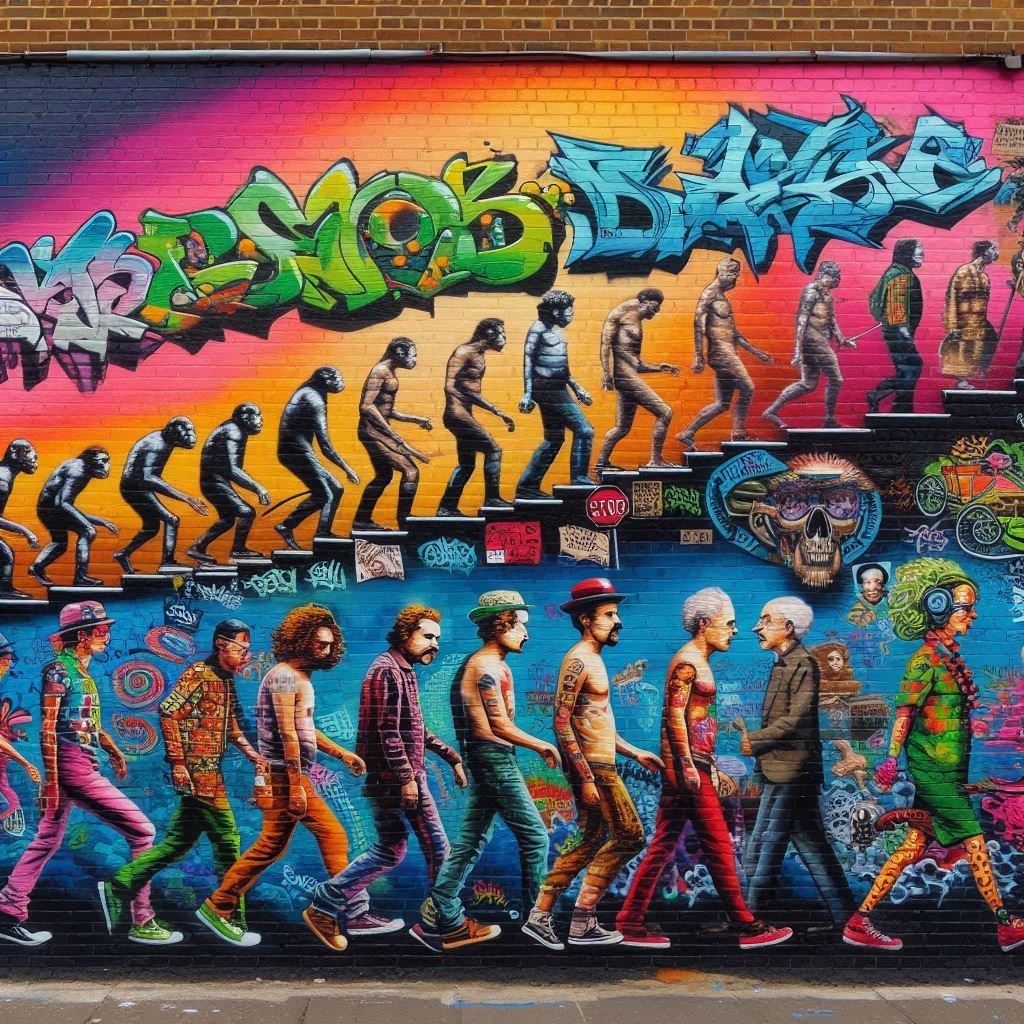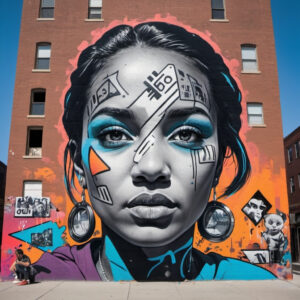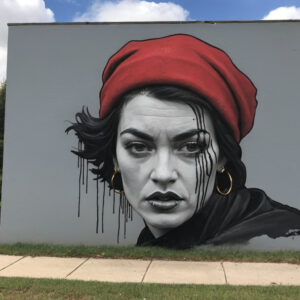
The Rise of Street Art in American Cities
We will discuss the history of street art, best streest artist and popular street art, rising street art interest in America
**The Rise of Street Art in American Cities: From Vandalism to High Art**
Street art has become an integral part of the urban landscape, transforming public spaces into vibrant canvases that tell stories, challenge social norms, and celebrate culture. Once dismissed as mere vandalism, street art has evolved into a respected and celebrated form of artistic expression. In American cities, this transformation is particularly evident as street art has transitioned from the fringes of society to the walls of prestigious galleries. This article explores the rise of street art in American cities, the history of the movement, the best street artists, and the most iconic pieces of street art that have shaped the cultural landscape.
**The History of Street Art**
**The Origins: From Graffiti to Street Art**
Street art’s roots can be traced back to graffiti, a form of expression that emerged in the late 1960s and early 1970s in the urban centers of the United States. Graffiti was initially a means for marginalized communities, particularly in New York City, to claim visibility in a society that often ignored or oppressed them. The early graffiti artists, or “writers,” used public spaces such as subway trains and building walls as their canvases, tagging their names or pseudonyms as a way to assert their identity and presence.
This era, often referred to as the “Golden Age of Graffiti,” was characterized by the rise of graffiti crews and the proliferation of large, colorful pieces known as “wildstyle.” These intricate designs required immense skill and were often executed under the cover of darkness due to the illegal nature of the activity. While graffiti was widely regarded as a form of vandalism, it also garnered attention for its raw, unfiltered energy and its role as a voice for the voiceless.
**The Evolution: From Graffiti to Street Art**
As graffiti gained popularity, it began to evolve into what we now recognize as street art. Unlike traditional graffiti, which focused primarily on lettering and tags, street art encompasses a broader range of artistic practices, including stenciling, wheat-pasting, murals, and installations. The shift from graffiti to street art marked a change in intent; while graffiti was often about self-expression and notoriety, street art began to address broader social, political, and cultural themes.
The 1980s and 1990s were pivotal decades for the evolution of street art. Artists like Jean-Michel Basquiat and Keith Haring, who started as graffiti writers, began to blur the lines between street art and fine art, bringing their work from the streets into galleries and museums. This transition was met with both acclaim and controversy, as the mainstream art world grappled with the idea of recognizing and legitimizing an art form that had long been considered criminal.
**The Mainstreaming of Street Art**
The 21st century has witnessed the mainstreaming of street art, with cities around the world embracing the movement as a legitimate form of cultural expression. Festivals, public art programs, and commercial collaborations have elevated street art from the streets to prestigious platforms. This mainstream acceptance has been both a blessing and a curse for the movement. On one hand, it has provided street artists with opportunities for recognition and financial success; on the other hand, it has sparked debates about the commodification and gentrification of street art.
In American cities, this tension is particularly evident as street art has become a tool for urban regeneration. Neighborhoods once characterized by economic decline have been revitalized through the creation of vibrant street art districts, attracting tourists and investment. However, this process has also led to concerns about displacement and the erasure of the very communities that gave rise to street art in the first place.
**The Best Street Artist: Who is the Best Street Artist?**
Determining the “best” street artist is a subjective endeavor, as the definition of greatness in art is often influenced by personal taste, cultural context, and the impact of the work. However, several artists have made indelible marks on the street art movement and are widely regarded as some of the most influential figures in the field.
**Banksy**
Perhaps the most famous street artist in the world, Banksy is known for his provocative and often politically charged stenciled works. Despite maintaining an anonymous identity, Banksy’s work has gained international acclaim for its clever use of humor, irony, and social commentary. His pieces often address themes such as war, consumerism, and the hypocrisy of the art world itself. Iconic works like “Girl with Balloon” and “Flower Thrower” have cemented Banksy’s status as a cultural icon, and his influence extends far beyond the streets, with his works fetching millions at auction.
**Shepard Fairey**
Another giant in the world of street art is Shepard Fairey, whose “Obey Giant” campaign and the iconic “Hope” poster for Barack Obama’s 2008 presidential campaign have become symbols of the power of street art to influence public opinion. Fairey’s work often incorporates elements of propaganda, challenging viewers to question authority and the messages they are fed by the media and political establishments. His style is characterized by bold colors, strong lines, and the use of iconic imagery, making his work instantly recognizable.
**Jean-Michel Basquiat**
Though he is often remembered as a neo-expressionist painter, Jean-Michel Basquiat’s roots in the street art world are undeniable. Starting as a graffiti artist under the pseudonym “SAMO,” Basquiat’s work on the streets of New York City in the late 1970s and early 1980s was a fusion of text and image, often addressing issues of race, identity, and social justice. His transition from the streets to the gallery scene was meteoric, and despite his untimely death at the age of 27, Basquiat’s influence on both street art and contemporary art as a whole remains profound.
**Keith Haring**
Keith Haring is another artist who bridged the gap between street art and fine art. His bold, graphic style, characterized by simple lines and vibrant colors, was initially developed in the subways of New York City, where he would create chalk drawings on empty advertising panels. Haring’s work often addressed themes of sexuality, AIDS awareness, and social justice, making him a prominent figure in the fight for LGBTQ+ rights. His public murals, including the famous “Crack is Wack” mural in Harlem, have become enduring symbols of the power of art to engage with social issues.
**Other Notable Street Artists**
In addition to these iconic figures, the street art world is home to countless other talented artists who have made significant contributions to the movement. Artists like JR, who uses large-scale photographic installations to highlight social and political issues; Swoon, known for her intricate wheat-paste portraits; and Invader, whose mosaic tile works inspired by video game characters can be found in cities around the world, are just a few examples of the diversity and creativity that define the street art movement.
**The Best Street Art: Iconic Works and Their Impact**
Street art is not only defined by the artists who create it but also by the iconic works that have left a lasting impact on the cultural landscape. These pieces, often located in public spaces, have become landmarks in their own right, drawing visitors from around the world and sparking conversations about art, society, and the urban environment.
**”Girl with Balloon” by Banksy**
One of the most famous pieces of street art in the world, Banksy’s “Girl with Balloon” is a simple yet powerful image of a young girl reaching out toward a red, heart-shaped balloon. The piece, which first appeared on a wall in London, has been widely interpreted as a symbol of hope, loss, and the fleeting nature of life. The image has been reproduced countless times, and its impact was further cemented when a framed version of the work famously self-destructed after being sold at auction in 2018.
**”Hope” Poster by Shepard Fairey**
Shepard Fairey’s “Hope” poster for Barack Obama’s 2008 presidential campaign is one of the most iconic images of modern political history. The poster, which features a stylized portrait of Obama in red, white, and blue, became a symbol of the campaign and the broader message of change and progress. The image’s widespread popularity demonstrated the power of street art to transcend its origins and become a part of the mainstream cultural and political discourse.
**”Crack is Wack” by Keith Haring**
Keith Haring’s “Crack is Wack” mural in Harlem is both an iconic piece of street art and a powerful social statement. Created in 1986 at the height of the crack epidemic in New York City, the mural features Haring’s signature bold lines and figures, along with a clear anti-drug message. Despite its initial controversy and the city’s attempts to remove it, the mural has since been restored and is now recognized as a significant piece of public art.
**”Les Enfants d’Ouranos” by JR**
French artist JR is known for his large-scale photographic installations that explore social and political issues. One of his most famous works, “Les Enfants d’Ouranos,” involved pasting massive photographs of children’s faces on the rooftops of buildings in Rio de Janeiro’s favelas. The project, which aimed to give visibility to marginalized communities, received international acclaim and highlighted the potential of street art to address social inequalities on a global scale.
**”The Flower Thrower” by Banksy**
Another iconic piece by Banksy, “The Flower Thrower” (also known as “Rage, the Flower Thrower”) depicts a masked protester in the act of throwing a bouquet of flowers instead of a Molotov cocktail.
Street Art’s Impact on American Cities
As street art gained popularity, it began to have a profound impact on American cities. Once confined to the fringes of society, street art became a powerful tool for urban renewal, social commentary, and cultural expression. Cities like New York, Los Angeles, San Francisco, and Miami became hubs for street artists from around the world, who used the urban landscape as a canvas for their work.
Urban Renewal and Cultural Revitalization
One of the most significant contributions of street art to American cities has been its role in urban renewal. In neighborhoods that had suffered from economic decline and neglect, street art has often been a catalyst for revitalization. By transforming abandoned buildings, empty lots, and neglected spaces into vibrant works of art, street artists have helped to reimagine and reenergize these areas.
The Wynwood Walls in Miami, for example, is one of the most famous street art districts in the United States. Once a neglected industrial area, Wynwood was transformed into an open-air gallery featuring works by some of the world’s most renowned street artists. The project, initiated by the late Tony Goldman, attracted international attention and played a key role in the revitalization of the neighborhood, turning it into a thriving cultural and commercial hub
The Future of Street Art in American Cities
As street art continues to evolve, its future in American cities remains uncertain. The movement has already had a profound impact on urban culture, but its future trajectory will depend on how it navigates the challenges of commercialization, institutionalization, and gentrification.
The Role of Technology
One of the key factors shaping the future of street art is the role of technology. Advances in digital tools and platforms have already transformed the way street art is created, shared, and consumed. Social media platforms like Instagram have played a crucial role in popularizing street art, allowing artists to reach a global audience and gain recognition beyond their local communities.
Technology has also opened up new possibilities for artistic expression. Augmented reality (AR) and virtual reality (VR) are being used to create immersive street art experiences that blend the physical and digital worlds. These new mediums allow artists to experiment with different forms of interaction and engagement, pushing the boundaries of what street art can be.
Balancing Tradition and Innovation
As street art continues to evolve, artists will need to balance tradition and innovation. While new technologies offer exciting possibilities, the roots of street art in graffiti and public intervention remain an essential part of its identity. Artists will need to find ways to honor these roots while also embracing new forms of expression.
This balance will also be important in maintaining the social and political relevance of street art. As the movement becomes more mainstream, there is a risk that it could lose its edge and become detached from the issues that originally inspired it. To remain impactful, street art will need to continue to engage with the social and political issues of the day, using its platform to challenge, provoke, and inspire.
The Ongoing Debate: Vandalism or High Art?
The question of whether street art is vandalism or high art is likely to remain a topic of debate for years to come. While street art has gained acceptance in many circles, it still exists in a legal gray area. In some cities, street art is celebrated and encouraged, with artists receiving commissions for public murals. In others, it is still considered a crime, and artists face the risk of fines and arrest.
This ongoing tension reflects broader societal questions about the role of art in public spaces and who gets to decide what is considered art. As street art continues to push boundaries and challenge norms, it will play an important role in shaping the cultural landscape of American cities.
